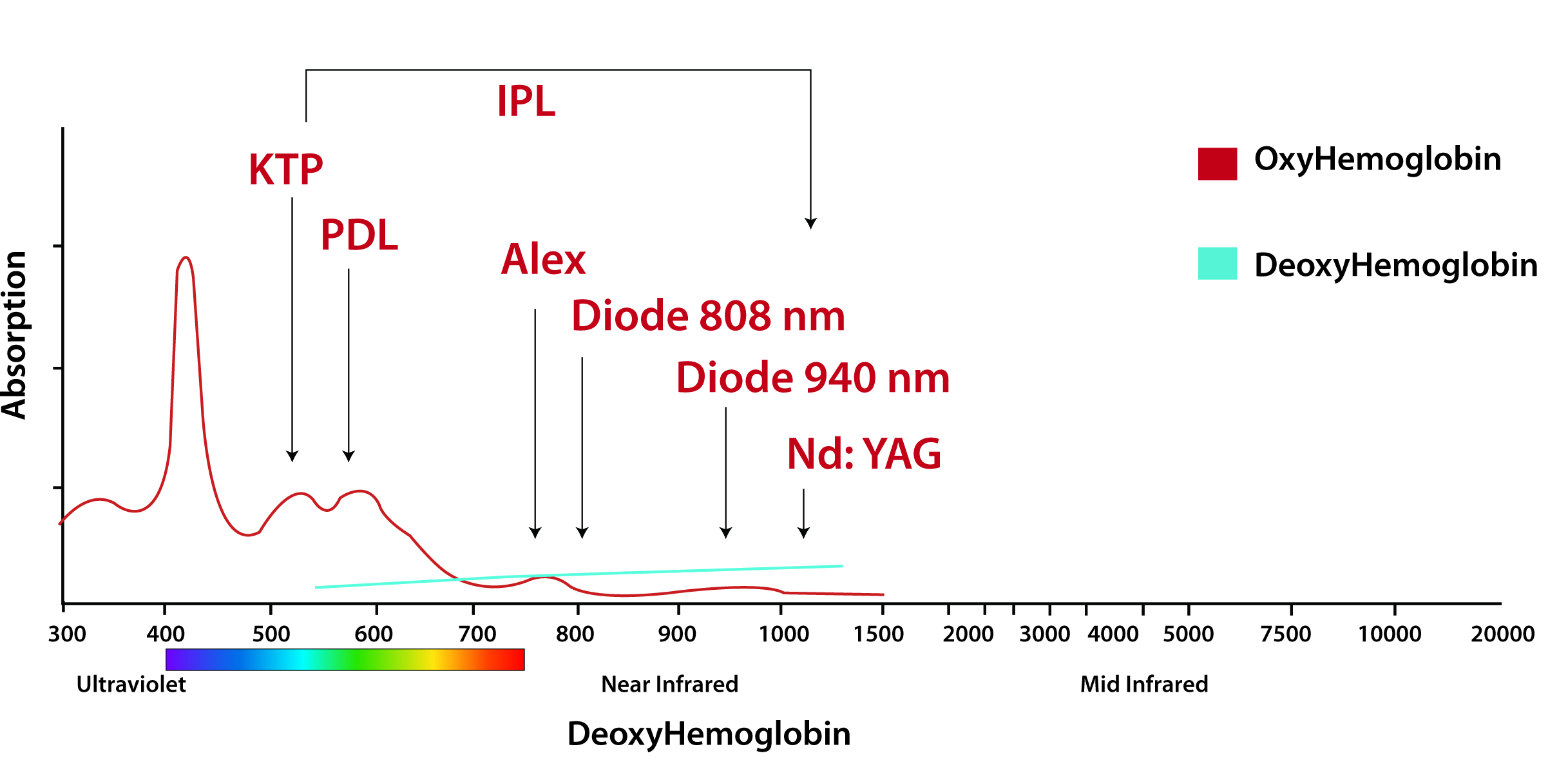▶ Previous Artlcle : #9-2. Q-switched Laser
In this chapter, let’s discuss the types of lasers for vascular lesions and hair removal as well as their effectiveness and safety.
Lasers for vascular lesions mostly use Oxyhemoglobin and Deoxyhemoglobin as the main absorber shown in figure 12-1, and remove abnormal blood vessels by selective coagulation. As mentioned in Chapter 11, since blood vessels have long Thermal Relaxation Time (TRT), long pulse laser with pulse duration of 1 ms (up to 300 ms) and high fluence is typically used for the treatment of vascular lesions. This rapidly increases the temperature of the epidermal layer during the treatment, requiring sufficient cooling with Tetrafluroethane (R-134a) or cooling water to prevent thermal injury. Pain or postoperative purpura can be substantially reduced by cooling the skin. Lasers that remove blood vessels by selective coagulation and their radiation profile will be discussed in 12-1.
HELIOSⅡ/LOTUSⅡ/HYPERION – Manufacturer: LASEROPTEK(www.laseroptek.com)
Laser for hair removal is mainly absorbed by melanin; the melanin in hair follicle is damaged by heat, preventing the hair from growing back again. This also requires sufficient cooling during the laser therapy to protect the epidermal layer. Lasers for hair removal and their radiation profiles will be introduced in 12-2.
12-1. Lasers for vascular lesions
1) Copper vapor laser (wavelength: 578.2 nm)
Copper vapor laser, also known as yellow laser, generates 511 nm green wavelength and 578.2 nm yellow wavelength, with the use of copper vapor as the gain medium. Being a gas laser, it produces laser by electrical discharge. The laser has about 20 ns pulse width and high repetition rate (6-12 kHz), making it appropriate for vascular lesions with long TRT. However, since 578 nm wavelength can be absorbed by melanin in the epidermis and dermis, post-procedural hyperpigmentation occurs frequently, especially in patients with darker skin.
2) KTP laser (wavelength: 532 nm)
A 1064 nm wavelength from Q-switched Nd:YAG laser incident on a nonlinear crystal called Potassium Titanium Oxide Phosphate (KTiOPO4, KTP) generates a 532 nm wavelength, which is called KPT laser or frequency doubled Q-switched Nd:YAG laser. The 532 nm wavelength is good for the treatment of vascular lesions since it is close to the wavelength of maximum absorbance of oxyhemoglobin (542 nm). The short penetration depth, however, prevents it from being used for vascular lesions in normal ways. In order to increase the penetration depth, Q-switched pulse train is generated continuously for dozens of ms, and this method is used also for the treatment of prostatic hypertrophy.
3) Pulsed dye laser (wavelength : 575-585 nm)
Dye laser is a liquid laser which uses a pigment called rhodamine 6G as a gain medium. One of the characteristics of pulsed dye lasers is that they use grating to change wavelengths, ranging from 563 nm to 625 nm when pumped with Xe flash lamp. The therapeutic effect can be maximized by converting the wavelength from 577 nm, which is oxyhemoglobin’s third maximum absorption wavelength, to 595 nm. For example, 450 us pulse width and 577 nm wavelength is used for microvascular lesions, while 1.5 ms pulse width at 585 nm wavelength or 1.5 to 40 ms pulse width at 595 nm wavelength is used for deeper, larger vascular lesions.
4) Laser diode (wavelength : 808-810 nm)
Laser diode is a semiconductor, continuous laser. Long pulse operation can be obtained by turning on/off the current input into the semiconductor laser. The wavelength of laser diode has relatively better absorption rate for melanin than 1064 nm but does not allow deep penetration into the dermis, precluding complete removal of hair bulbs.

Figure 12-1. Absorption by the wavelength of absorbers (Oxyhemoglobin, Deoxyhemoglobin)
-To be continued-
▶ Next Artlcle : #10-2. Long Pulse Laser





















